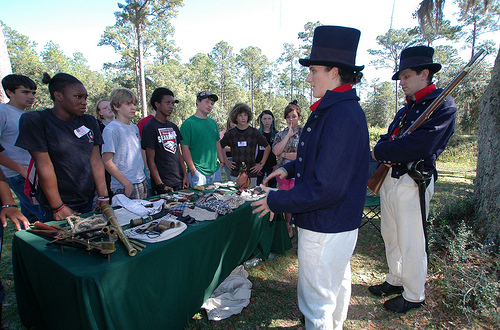Florida Students Go Back in Time on Their National Forest

Juliann and Matthew Krogh, members of the Coast Guard Historic Ship’s Company, give a living history presentation to Franklin County, Fla., middle school students recently at historic Fort Gadsden on the Apalachicola National Forest. (U.S. Forest Service Photo/Susan Blake)
More than 100 Franklin County middle and high school students got to explore the life of an 18th century sailor through a living history program presented by employees of the National Forests in Florida and the U.S. Coast Guard.
The backdrop was the historic Fort Gadsden on the Apalachicola National Forest, a landmark listed on the National Register of Historic Places.
Students and teachers participated in hands-on demonstrations with Coast Guard Auxiliary historians working with the 1812 Historic Ship’s Company, established by the Coast Guard as part of its bicentennial commemoration to inform the public of its role during the War of 1812. Forest Service archaeologists hosted an interpretive tour of the site.
“Life was not so easy for sailors during the 18th century. If you were biting the bullet, most likely you were having a limb amputated and a ration of food might contain a weevil-infested sea biscuit,” said Matthew Krogh, a living historian with the Coast Guard Auxiliary.
Fort Gadsden, about 25 miles from Franklin County High School in Eastport, Fla., and 75 miles southwest of Tallahassee, Fla., flourished as a military installation during the early 19th century. The area’s rich maritime history spans Spanish and British occupations, the War of 1812, the acquisition of Florida by the United States in 1819 and the Civil War. Escaped slaves also found refuge within its walls.

Forest Service archaeologist Rhonda Kimbrough gives an interpretive tour of historic Fort Gadsden on the Apalachicola National Forest in Franklin County, Fla., to middle school students late last year. More than 100 middle and high school students attended the event which directly relates to their current school curriculum. (U.S. Forest Service Photo/Susan Blake)
“Places of international historical significance can be in your backyard,” said Rhonda Kimbrough, Forest Service archaeologist. “Strategically situated on the east bank of the Apalachicola River, the location was remote, but ideal for waterway transportation and commerce with its direct river access connecting the Gulf of Mexico with inland plantations and other resources.”
For the presentation with the Forest Service, Coast Guard Auxiliary members dressed in period naval uniforms. They showed students navigation techniques, depth finding with lead lines, weapons use and what can now be considered primitive surgical and medical practices. They offer similar presentations throughout the year for other Coast Guard activities and events.
“Hands-on teaching like this and discussion about the importance of the historical significance allows the students to touch, feel and hear history. It’s a very, very powerful thing,” said eighth-grade teacher Kris Bray.
